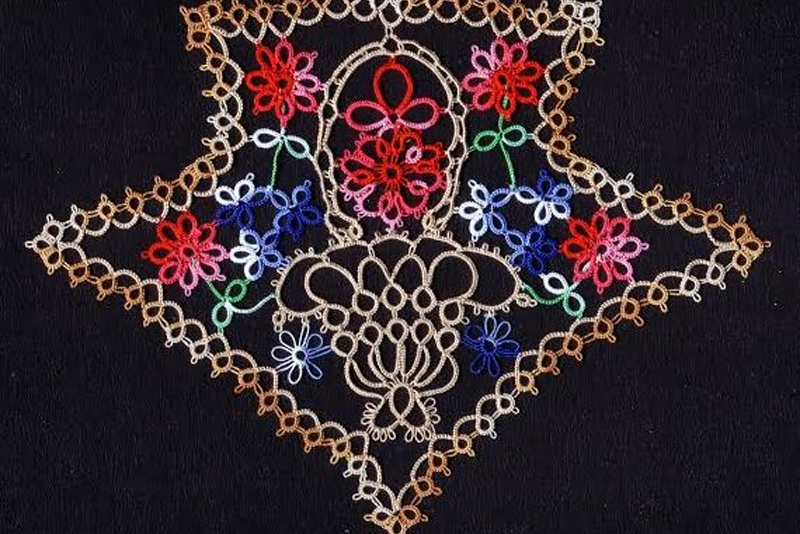Martha Ess, author of the recently published book, "Picot Play", has been doing research on tatting. She noticed a similarity in some patterns in the Emmy Liebert book, "Schiffchen-Arbeiten" (1916), with patterns in an earlier book "The Lace Tatting Book" (1866.) She wrote:
"Figure 24, page 104 of the Liebert book that you mentioned in your message to the class has been on my mind for a while. It bears an uncanny resemblance to the cone section of Mlle Riego's parasol cover in "The Lace Tatting Book" 1866, but I haven't found the time to work out the stitch counts of both to be sure. What do you think? See also Riego's d'oyley, page 17-19 of the same book, built up from 6 of the cone motifs. I wonder if Liebert's somewhat more fanciful 9 sided "Feines Deckchen" (Delicate Tablecloth) was inspired by it?"
Martha refers to the works of Mlle. Eleonore Riego de la Branchardiere. Mlle. Riego published her first book, "Knitting, Crochet and Netting" at the age of 12 in 1846. She went on to publish 72 books on the needle arts of which 13 were tatting books (11 books and 2 reprints.) Mlle Riego began with borders and insertions in tatting and went on to create gold-medal award winning tatting featured at the world expositions 1851, 1855, 1862 and 1872. All of her books are in public domain and may be downloaded free. (Please see http://www.bellaonline.com/subjects/3137.asp under the Archive of Tatting Books in the Public Domain.)
The Simple Book of Tatting, 1850
The Tatting Book, 1850
Golden Stars in Tatting and Crochet [Etoile Dorée in Tatting], 1861
Tatting Edges and Insertions, 1861
The Exhibition Tatting Book, 1862
The Royal Tatting Book, 1864, 1867
The Complete Tatting Book, 1866, 1867
The Pearl Tatting Book, 1866
The Lace Tatting Book 1867
The Raised Tatting Book, 1868
Lace Tatting. Tatting chapter only from the Irish Lace Instructor, 1886
This is Martha's sample of the Riego pattern.
http://www.georgiaseitz.com/bella/essriegoparasol.jpg
To follow Martha's conclusions please compare these pages:
pg. 4 - 11 http://www.georgiaseitz.com/public/riego/riego08thelacetattingbook.pdf
Bonnet pgs 17-19 Mlle Riego De La Branchardiere The Lace Tatting Book 1866
with
Emmy Liebert "Schiffchen-Arbeiten" Book 2 pg. 16 fig. 24
http://antiquepatterns.dreamhosters.com/LiebertShiffchen2.pdf
Martha concluded:
"My final conclusion is that the Riego and Liebert motifs aren't exactly the same, but have such a close resemblance that one must have been inspired by the other."
Construction: Riego makes the center and the outer rounds first and the inner round last. Liebert works from center outward.
Center: Liebert’s rings have slightly fewer ds, but the number of picots is the same.
Inner round: At the rounded end, Liebert interrupts the back and forth pattern to make 3 large rings with no small ring between them. Except for this, the stitch and picot counts are the same for the two motifs.
Outer round:
Minor differences: Liebert’s edging pattern chains are 3 - 2 - 2 - 3 where Riego’s are 2 - 2 - 2 - 2. Some of the joins to the large ring are shifted over 1 picot. The small rings joining the inner round are written as 3 + 1 + 3, though they appear larger in the photo. Riego’s corresponding rings are 3 + 3 + 3. Since Riego made the outer round first, she must tie together picots of the small rings near the point, while Liebert is able to work a join in the same spot.
Major difference: Riego has 3 “free” repeats of the edging at the point of the cone, where Liebert has only one.
Note: Though it is not evident in the engraving, Riego’s pattern has the large ring at the point of the inner round join to the large rings of the edging on each side. When Liebert says: “An der spitze des ovals warden rechts und links je 1 Aussen-figur direct mit dem innenr. Und 2 oe. an den obersten grosse R der 2. Reihe angeschlossen,” I think she is doing the same thing, though she isn’t clear which picots to join.
This will also be of interest in the comparisons:
first illustration of The Irish Lace Instructor
http://www.georgiaseitz.com/public/riego/riego12theirishlaceinstructor.pdf
parasol and bonnet plus collar and cuffs small booklet
I certainly agree with Martha's findings. I believe the extra joins at the pointed end of Riego's motif might have been needed for stability and durability of the parasol as it was a daily use item for outdoors. Liebert might have altered her version deliberately as it was to be used as a tablecloth.
All these vintage publications are a never ending source of inspiration for tatters.
Ed.'s Note: I acquired all these books for my own personal reference library over the last 3 decades. -G. Seitz
Here's the latest article from the Tatting site at BellaOnline.com.
Workbasket Pattern List 1945-54
A list of the issues of the Workbasket Magazine and the tatting patterns in them from the first issue 1945 through 1954.
http://www.bellaonline.com/articles/art31814.asp
Please visit tatting.bellaonline.com for even more great content about Tatting.
To participate in free, fun online discussions, this site has a community forum all about Tatting located here -
http://forums.bellaonline.com/ubbthreads.php?ubb=postlist&Board=39
I hope to hear from you sometime soon, either in the forum or in response to this email message. I thrive on your feedback!
Have fun passing this message along to family and friends, because we all love free knowledge!
Georgia Seitz, Tatting Editor
http://tatting.bellaonline.com
One of hundreds of sites at BellaOnline.com
tatting Newsletter







